Versions 1.21.x
Changes and news
Version 1.21.0.1
Configuration - controlling/competence/attendance - hide flag instead of showing
In the configuration part, the accessibility logic of some functions and views has been changed. If a given client has access to a module, e.g. Finance, all module functions are now enabled by default. It is only in the configuration that you can selectively hide them if you do not use their functionality.
Applies to:
-
finance module - controlling views
-
employee module - views of competence check/attendance registration in the mobile part

| Availability: Finance/Employees |
KC authorization - access to profile settings on the KC system
When using the system on the AMAGE24 platform with a central login system, a button appeared in the configuration and user information window that allows you to go to the login system and change the password / enable two-factor login (2FA), etc.
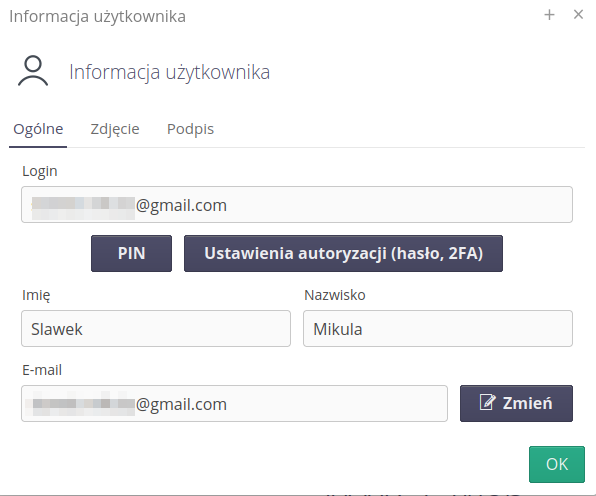
| Availability: Authorization |
Mobile - integration of older tasks - adding a message and operation status
In the configuration module for devices with the option of offline work, the ability to integrate older tasks that were sent from mobile devices and were not automatically entered into the system has been added. This action is available only for items in the Done mode.

| Not all operations are possible via the Web system. For devices with the Fx application, the central Sync synchronization system is used for this and in this case an appropriate message will appear. |
| Availability: Mobile |
Supervision - automatic creation of parameters in the asset if they did not exist before
In the supervision module, during the definition of the supervision template, we can enable the option that will automatically create the missing parameter in the registered asset when it was not previously specified.
This allows for a simpler definition of supervision tasks. It is enough to specify any parameter that we want to monitor and the system, at the time of the first registration of supervision requiring such a parameter, will create it and automatically save these values.

| Availability: Supervision |
Supervision - separate tabs for parameter templates in the general view
In the supervision template definition, you can specify that the template should always be visible in the supervision elements view. This allows you to display relevant governance templates always visible in the view without having to set filters and views accordingly.
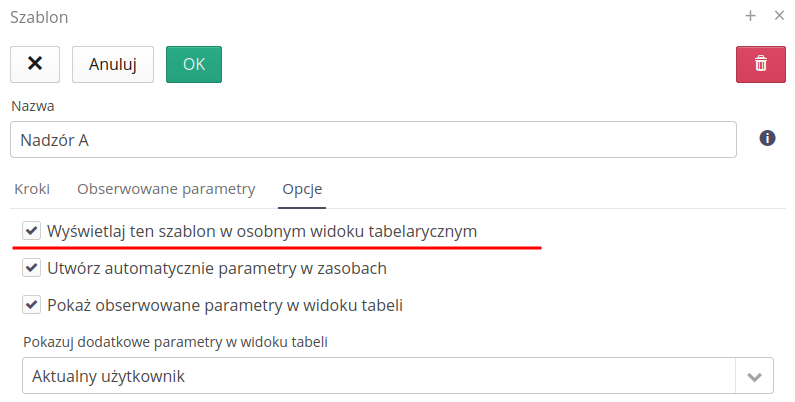
| Availability: Supervision |
Supervision - view of elements - view in columns of values of recorded parameters
When configuring supervision, you can specify that all supervised parameters are displayed in the tabular preview of the supervision view.
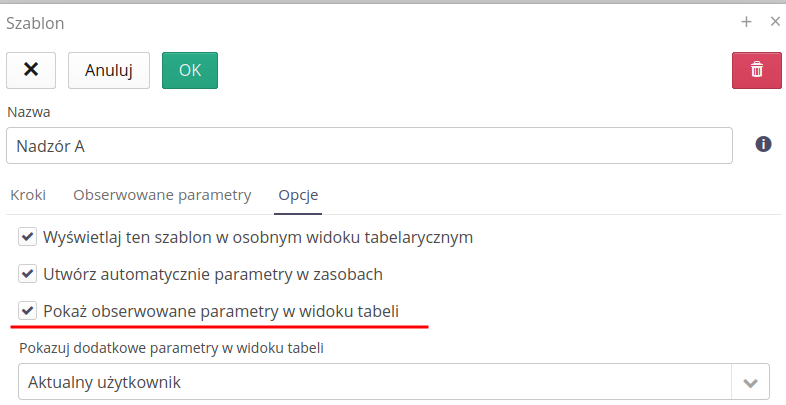
After enabling this option, the system automatically adds columns with monitored parameters to views that are configured to display a given template.

| Availability: Supervision |
Supervision - template - list of parameters always displayed
During the definition of supervision, it is possible to define additional (any) parameters that will be displayed in tabular views of supervision.

| Availability: Supervision |
Supervision - supervision template - asset scan type field (select, scan)
During the definition of monitored parameters during supervision recording, it is possible to specify a specific type of parameters. One of them is resource types. This allows you to specify that you want to save the resource in this parameter and be able to select it.
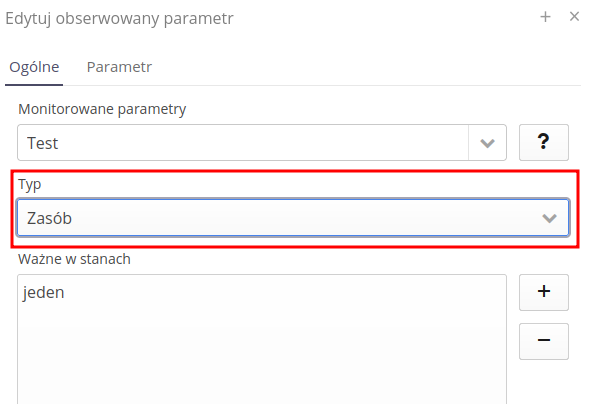
During supervision recording, this parameter is displayed as a checkbox and code scan. We can select any resource for this field or scan the code that is assigned to this resource (previously printed and marked on the device).

| Availability: Supervision |
Supervision - supervision template - user scan field (select/scan)
During the definition of monitored parameters during supervision recording, it is possible to specify a specific type of parameters. One of them is user-related types. This allows you to specify that you want to save the user in this parameter (e.g. participating in the process) and be able to select it.
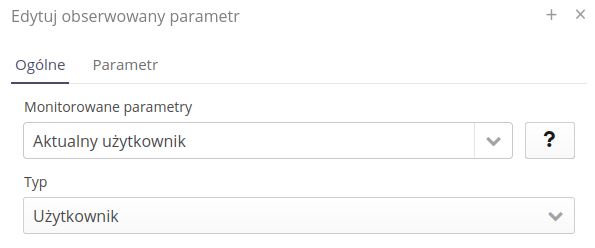
During supervision recording, this parameter is displayed as a checkbox and code scan. We can select a user for this field or scan the code that is assigned to this user (previously printed and marked on the device).

| Availability: Supervision |
Supervision - supervision template - serial/inventory number type field
In definitions of parameters supervised by the user, it is possible to specify the type of the recorded parameter as an inventory number.
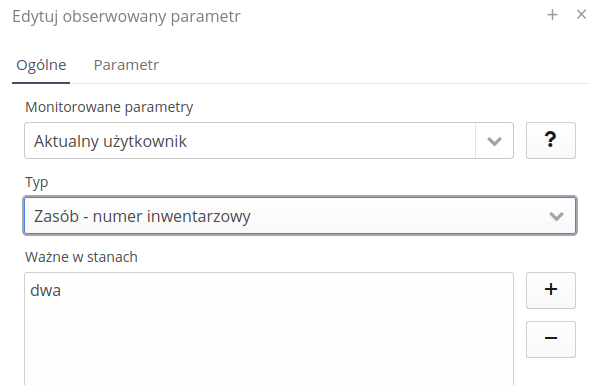
In this case, at the time of registration, the entered number is saved as an asset parameter AND the asset inventory number is updated.
| Availability: Supervision |
Supervision - supervision registration - entering numbers - adding +/- buttons
If we have defined the supervised parameter as a number and the reminder of the previously entered value for this parameter is set, the system displays additional + and - buttons in the parameter registration line, which allow you to increase/decrease the (integer) number visible in the parameter. This allows you to quickly add/subtract a specific small number from the current value.

| Availability: Supervision |
Supervision - determination of geolocation when changing state
During supervision definition, it is possible to specify that geolocation (place of registration) should be provided when registering a specific state. This allows you to update the location of the resource at a specific location.

During registration, the system automatically updates the location (authorization to access this data on the Android platform or in a web browser is required).
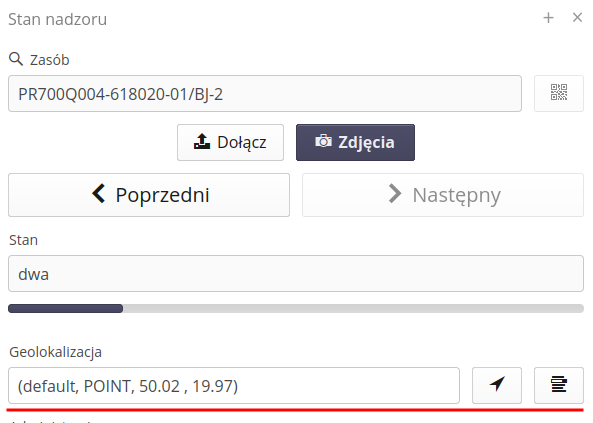
An additional button appears in the supervision details view to display the location of the resource. The resource is also shown on the map.

| Availability: Supervision |
Supervision - view of supervision states - add an option to the status "show column with date entered", "show user login"
When defining the supervision status, an option was added that allows you to show in the summary view (table) next to information about the registration of a given status, additional information about the date of registration and the person (login). These two columns are defined separately for each state.
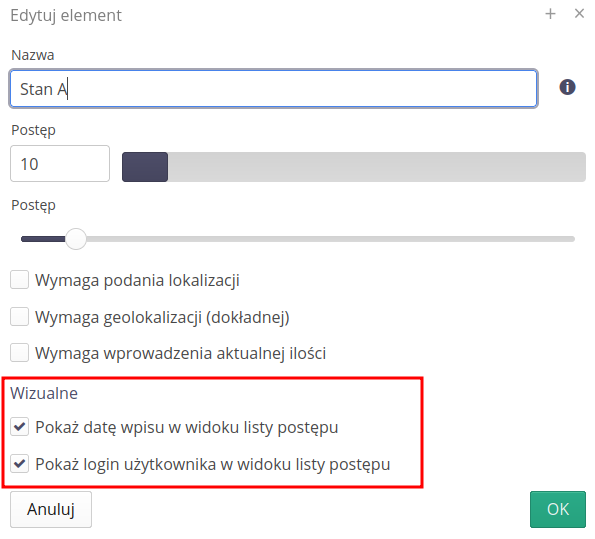

| Availability: Supervision |
Supervision - supervision view - view export to xls format
For additional views defined in the supervision template definition, an option to export the current view and the records set therein to an XLSX file has been added. The option is available as in the case of other views at the bottom of the table.

| Availability: Supervision |
Supervision - supervision filter - the ability to add a group/location directly from the filter view
In the supervision view (table), the option to add new items directly from the filter view has been added to the location and product groups filter. The same function as in the resource view.

| Availability: Supervision |
Supervision - resource parameter - option to limit the resource in relation to the search field (e.g. only of a given type, category)
For a registered parameter in the supervision module, we can specify that a given parameter is a resource. It can be scanned with a code, but it can also be selected manually. This change adds the ability to specify a fine-grained filter that will limit the items that are displayed in the selection list.
With the help of filters, we can limit resources to a given type, category of types or specified in a location/group of products.
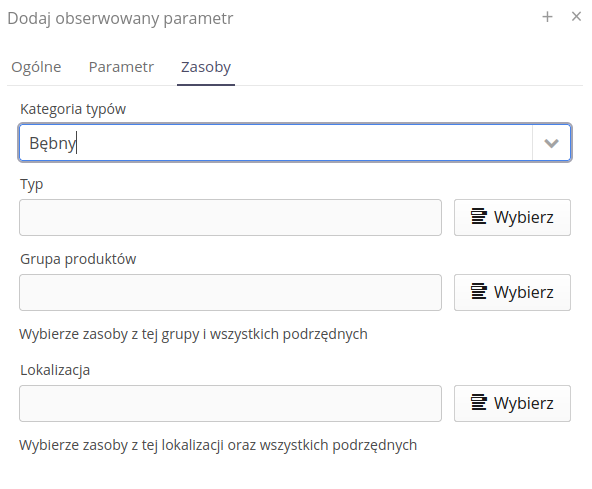

| Availability: Supervision |
Supervision - identifier parameter - after saving, we add/update the identifier in the resource
A new type of registered parameter has been added. The type is Resource - ID. After selecting this option, after reading the value of such a parameter, we can immediately save it as a new resource identifier.
This allows you to quickly add identifiers to resources. Using the inventory module, we generate labels with identifier codes in the number of, for example, 100. Then, when labeling devices/machines/components with codes, we immediately register the given code and scan it. The system will automatically add this code to the list of identifiers.
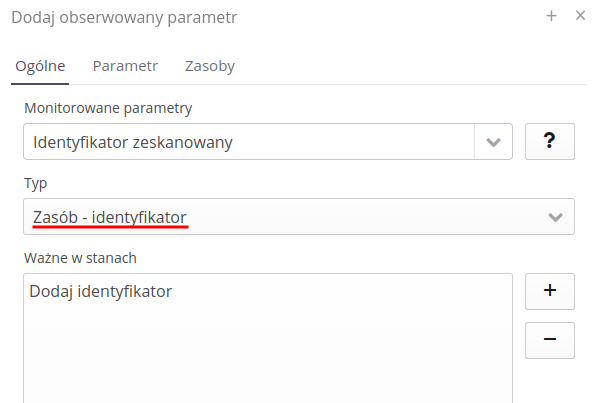

| Availability: Supervision |
Supervision - text parameter - option - generate value from counter
When registering a supervised parameter, you can specify that the system allows you to enter a counter value in this parameter, i.e. one that automatically increases.
This approach allows, for example, to define a meter that will generate an inventory number code and then use this generator to assign subsequent inventory numbers for registered devices. Of course, the function can be used for any purpose.
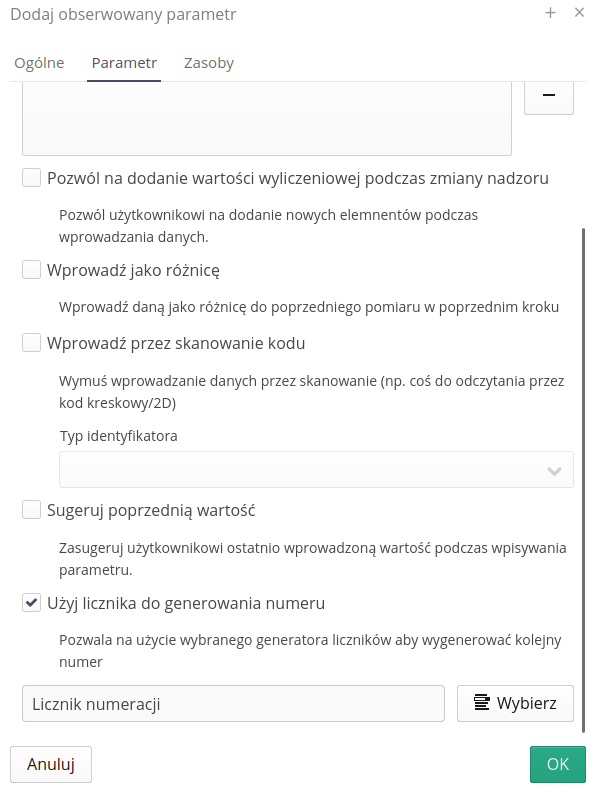
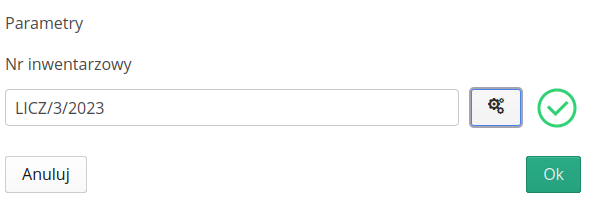
| Availability: Supervision |
Supervision/Integration - supervision history importer
In the data import section in the system, the option to import supervision history has been added. This allows you to import data into the system from already existing spreadsheets with manual progress reporting. With the help of this importer, we can import data along with the entire history of their registration. This makes it much easier to transfer information about ongoing works, when they have already started.
The importer is available in the system configuration section.

After defining the structure, parameters and mapping, the importer takes care of the entire operation, including entering all data, completing parameters and saving the supervision history.
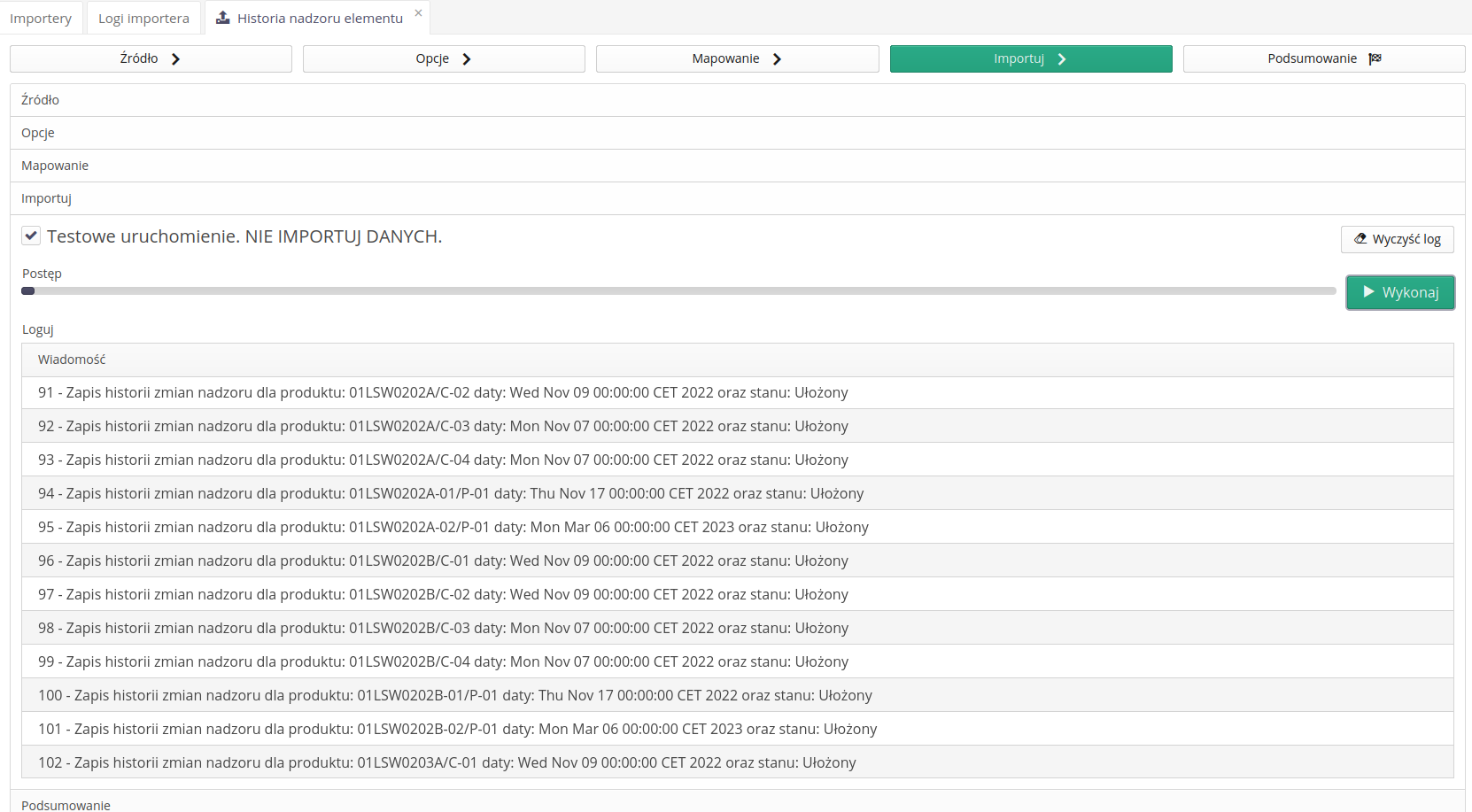
| Availability: Supervision/Integrations |
Version 1.13.0.12 (legacy)
GlobalId view, IFC Tag in ID view
In the view of identifiers for Location, Product Group, Product, information about identification parameters from the IFC model appeared. GlobalId/TAG parameters, when imported, appear in the identification dialog that facilitates element identification in 3D models.

| 1 |
Helpdesk tickets - disabling the option of creating tickets from the application
In the system configuration flags, there is an option to disable the possibility of creating service requests in the AMAGE support system directly from the application. For On-Premises systems operating in total isolation, this may not be possible.

| Support is always available to users through our main HelpDesk system available through the company’s main website. |
| Availability: Everywhere |
Users - when a user from the invitation logs in for the first time, display the personal data settings window
Users who are invited by sending activation links to an email address do not have their names set correctly by default. In this case, when the application is launched for the first time, the welcome window will also contain fields to complete this information.
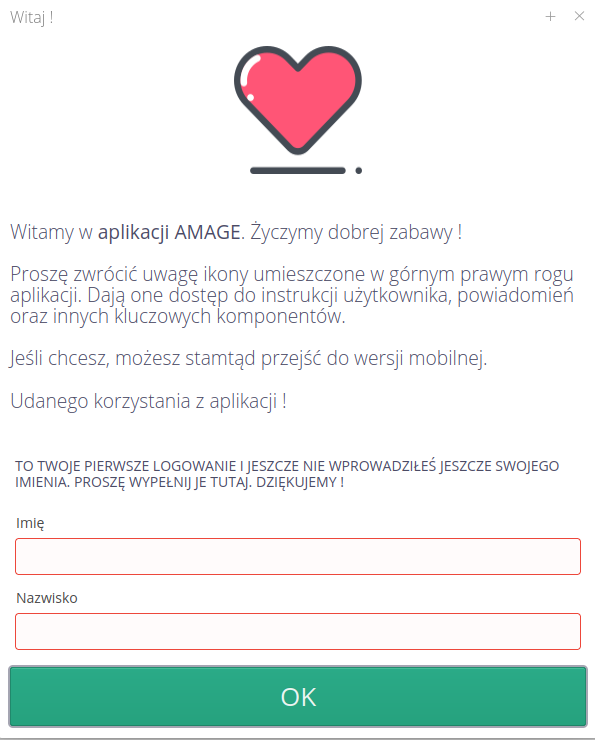
| Availability: Everywhere |
Users - invitations - behavior modifications
The mechanism of user invitations has been modified so that:
-
it was possible to send multiple invitations at once to multiple email addresses
-
at the end of the operation, a message appears with the status of each upload
-
if the user already exists, the invitation is not sent
-
Fixed some logical bugs.
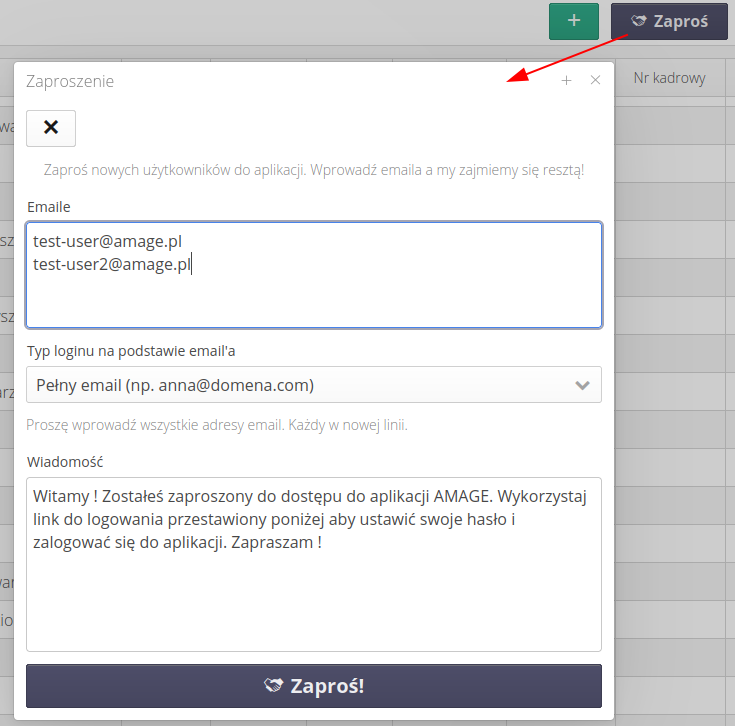
| Availability: Authorization |
Scheduler - options - do not perform operations in terms of hours, time
Additional options have been added to the automation definition. In each case, you can additionally specify the hours between which the machine will not be activated. This allows you to specify, for example, hours when the external IT system is unavailable or we should not generate information during the night.
In the scheduler definition, we can now specify the range of hours in which the given machine, despite setting the calling period, will not be launched.
For example. We define a call every 1 hour BUT do not allow the machine to start between the hours of 23:00 and 06:00 in the morning.
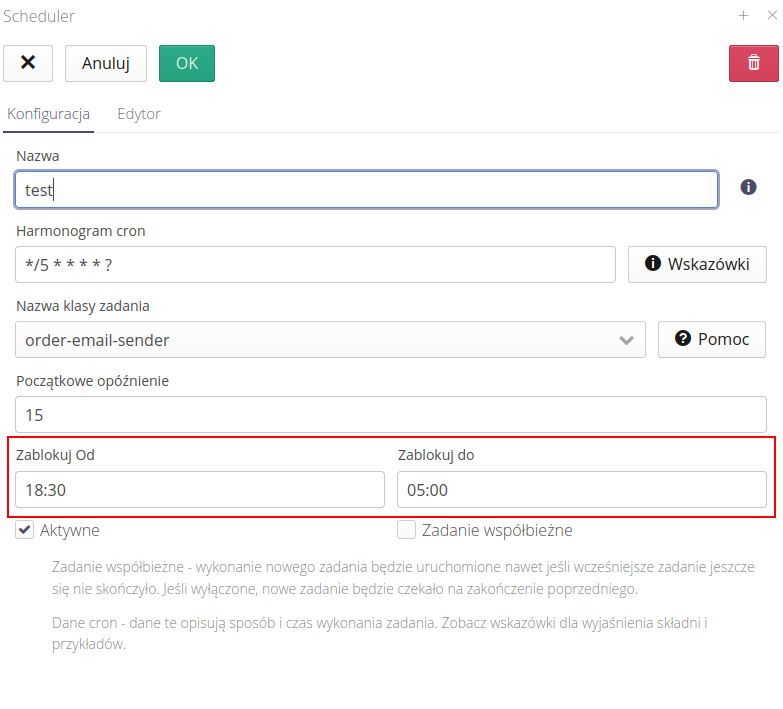
| Availability: Integrations |
Scheduler - settlement of registration to attendance
An attendance registration settlement machine has been added to automatic systems. It is a simplified algorithm that settles attendance registrations in the Entry-Exit range and calculates the sum of the presence of a given person in accordance with such registrations.
We turn on the machine according to the documentation. It will periodically recalculate the presence in the given time range (this month, the previous month, the range of days FROM-TO back, e.g. 7-14).
More information can be found in the automation documentation at the AMAGE Academy.
| Availability: Employees |
Attendance - adding attendance manually in the system
In the attendance view, it is possible to manually add new attendance entries. This can be useful when an employee has not registered entry/exit, or we account for attendance on our own or import from external systems and the data did not appear. In the dialog window, we have the option of adding all the data directly.
Adding a attendance is possible from the general view.
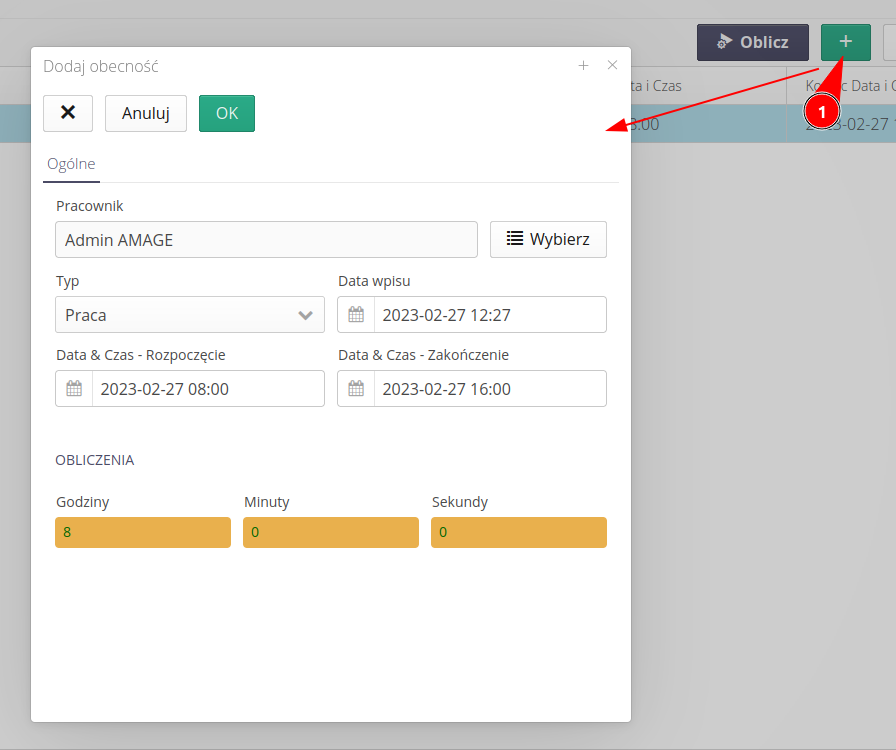
And from the employee details view.

| Availability: Employees |
Attendance registrations - manually added in the system
In the attendance registration view, new registrations can be added manually. This allows you to complete or modify the registration. This can be useful when an employee has not registered his/her attendance with the devices or modification of records is required.
Adding attendance registration is possible from the general view.
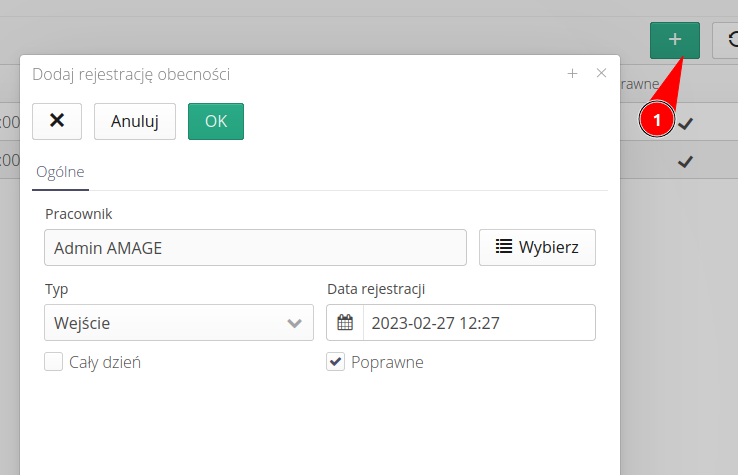
And from the employee details view.

| Availability: Employees |
Attendance - automatic calculation of attendance
The mechanism for calculating attendance based on registration has been made available in the user interface. Calling the registration settlement is possible from the main presence view.
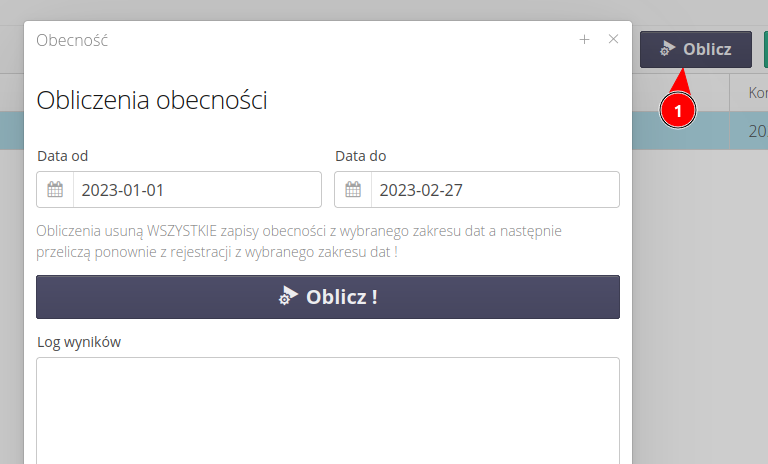
| You can run the automaton directly from the user interface. In addition, you can run an automaton that will run in the background and automatically recalculate the attendance time of employees within a specified date range. See the documentation of automations at AMAGE Academy |
| Availability: Employees |
Attendance view - calendar tab
An additional tab with a calendar view has been added to the attendance view. The view presents all information regarding attendance registration and attendance calculations for employees. We can filter by the selected employee.

| Availability: Employees |
Integrations - SQL backend for parameter import mapping
The ability to integrate with external systems via direct access to databases has been added to the system. After defining the communication endpoint to the database - currently supported by Microsoft SQL Server, PostgreSQL Server, Firebird SQL Server - we get the possibility to define the module executing SQL - production parameters.
In it, we define a query that will retrieve data from an external system and modify the external database after the task is completed.
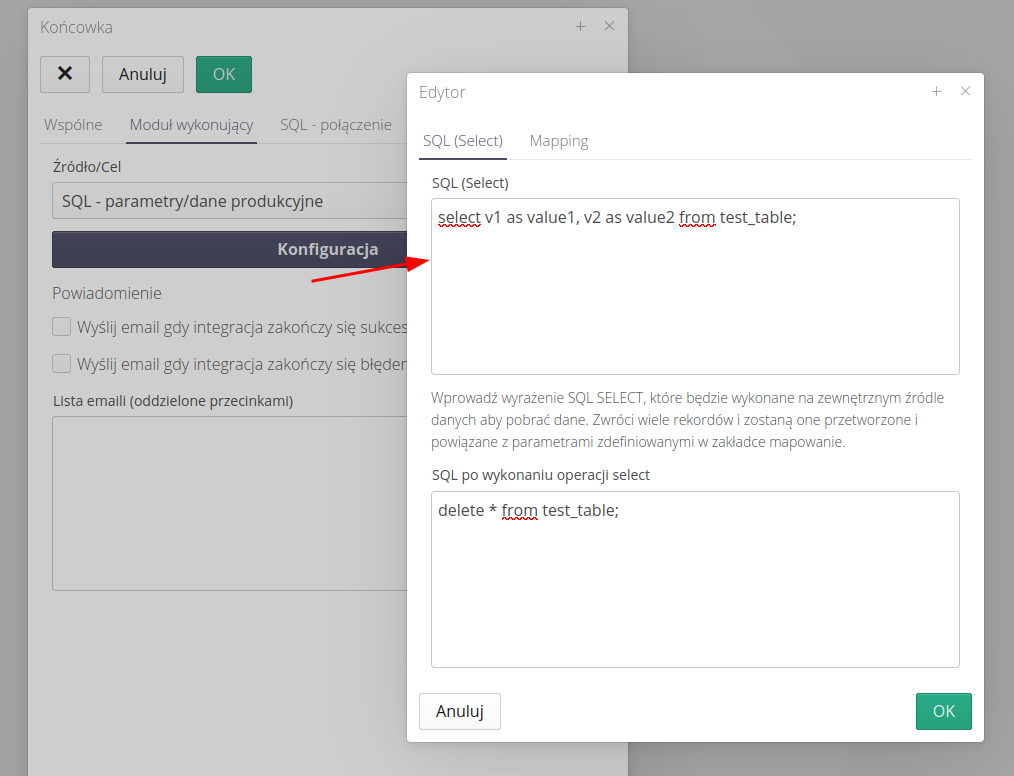
Next, we define the mapping of parameters extracted from the database to production parameter values or resource parameters.
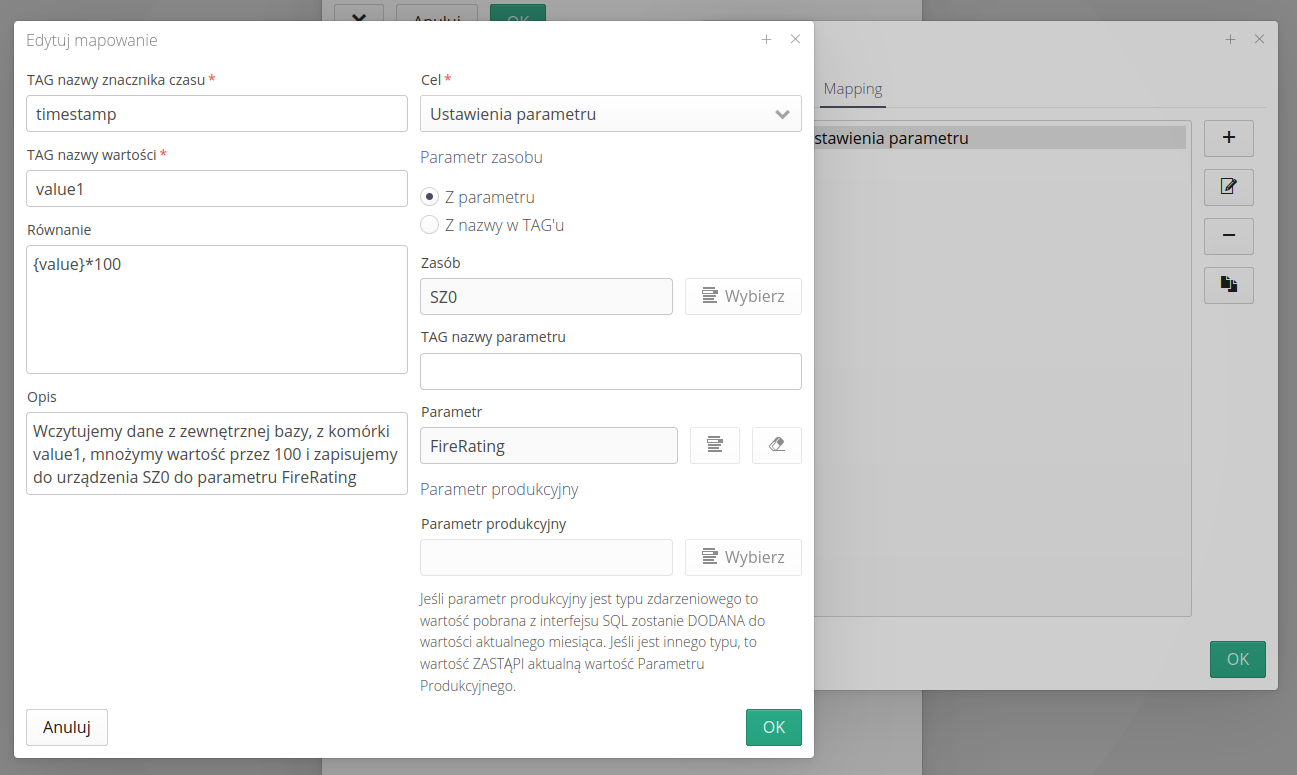
The effect will be to retrieve data from an external database and load it into the appropriate structures in the AMAGE system.
| Availability: Integrations |
Integrations - sql backend for any remote database modification
SQL extensions for Data export have been extended with an additional execution element in the form of any SQL queries. This allows for continuous updating of data in external databases, e.g. by providing data relevant for additional integration.
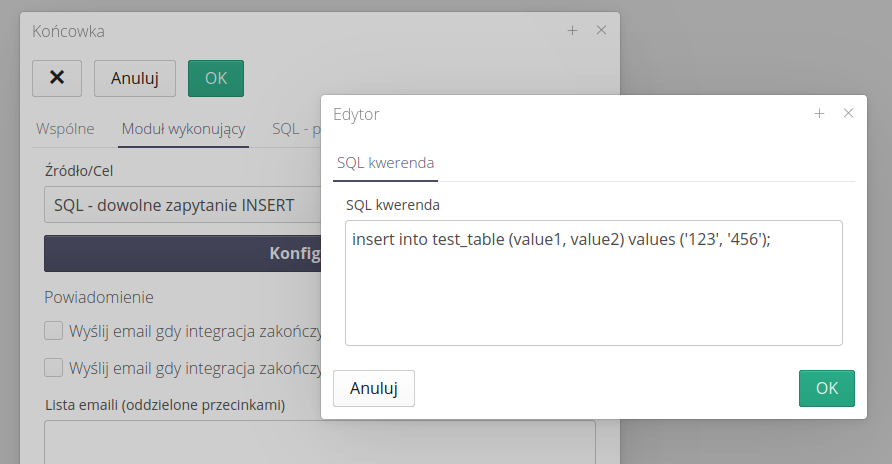
| The SQL editor is available only when the data exporting endpoint is selected! |
| Availability: Integrations |
Integration - Backend sql
The automatic integration system has been extended with the possibility of defining sources/destinations as a database on a relational database server. The following databases are currently supported: Microsoft SQL Server, PostgreSQL Server, Firebird SQL Server.
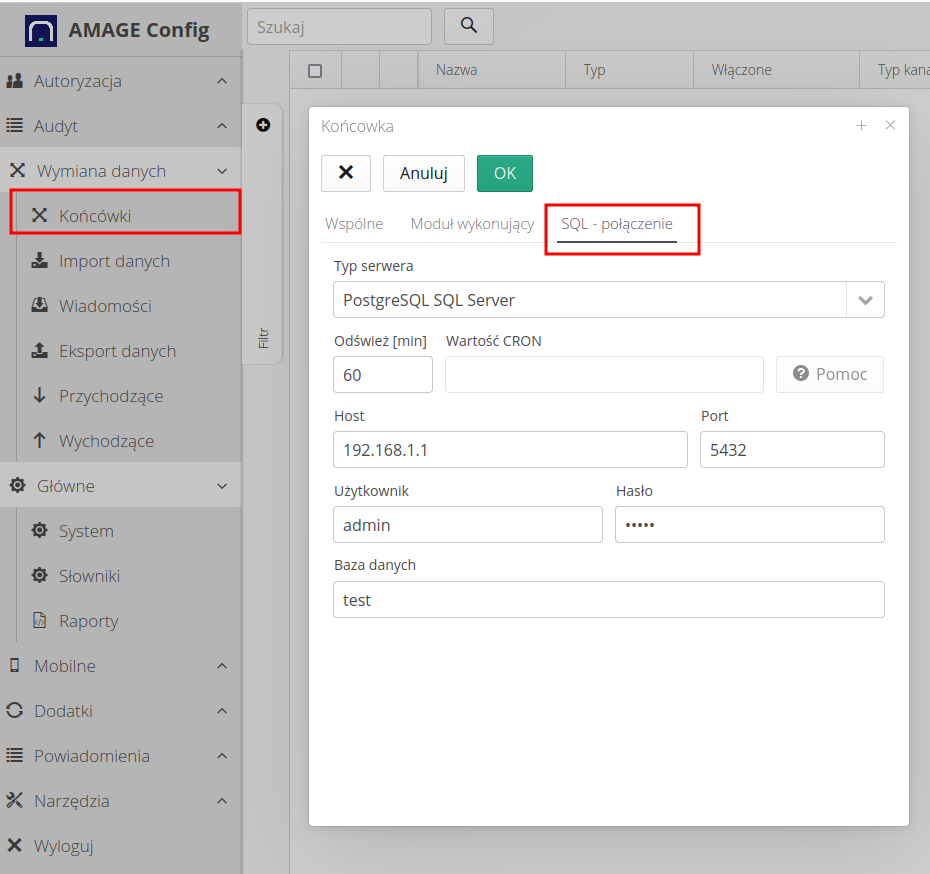
The SQL end can be used for a number of communication operations using relational queries and data transfer to/from the AMAGE system.
| Availability: Integrations |
Schedulers - a place to log work/errors/exceptions of scheduler work, message viewer
All automations, event processing and integrations have been enhanced with additional detailed logging of their operation so that this data can be made available to administrative users of the AMAGE instance. The preview is available in the system configuration section of the Audit menu.
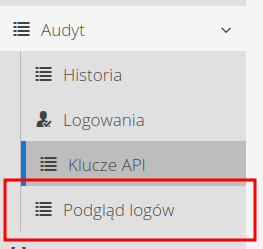
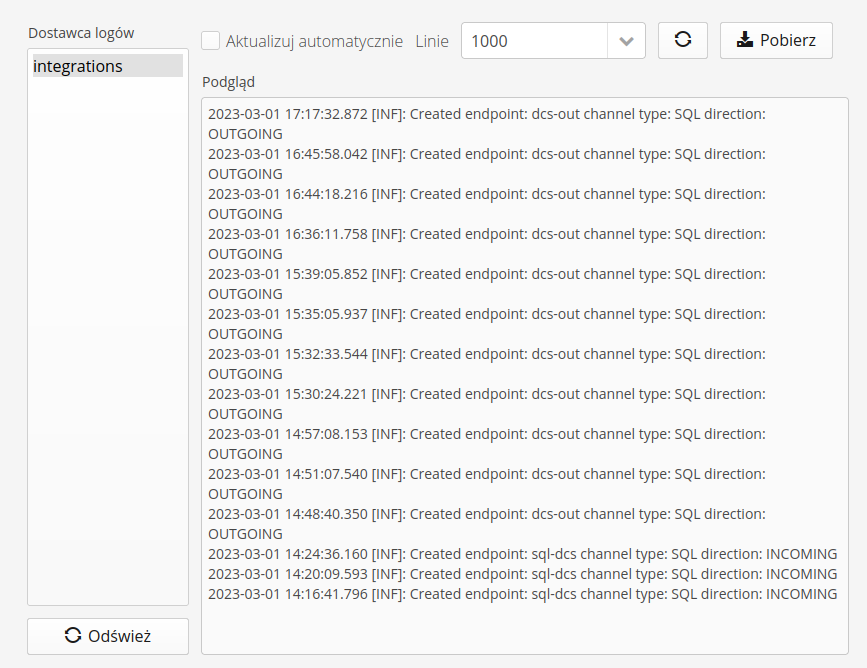
With its help, we have the ability to view configuration data, current operation of automations and integrations, and diagnose errors or incorrect communication.
| Availability: Integrations |
Log synchronization - after sending logs to the server, delete local logs
AMAGE Fx application has been extended to automatically delete communication logs after they are successfully sent to the server. This allows for efficient diagnostics of the application’s operation on offline mobile devices but also to skip the duplication of diagnostic data.
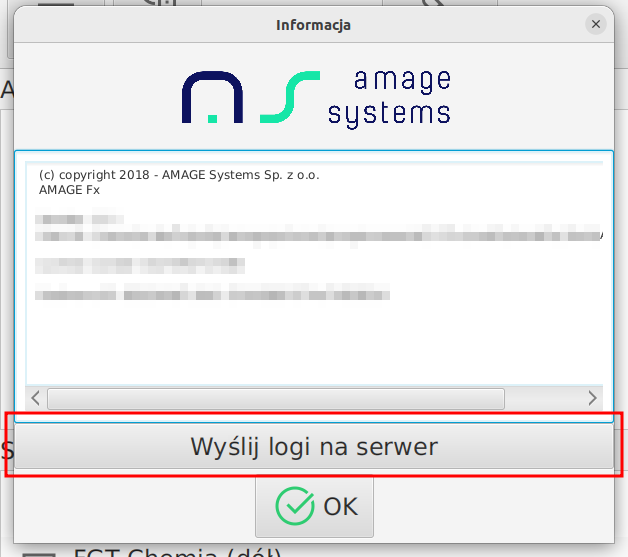
| Availability: Mobile/AMAGE Fx |
Wi-Fi connection error - appropriate message
In the case of communication errors with the master server in the AMAGE Fx application, more detailed messages appear indicating the potential source of the problem. For an offline application, synchronization can be triggered even before the module is properly connected to the network or server. Messages allow for easier diagnosis and repair of the problem.

| Availability: Mobile/AMAGE Fx |
Energy dashboards - modification of dashboard definition interface
Energy dashboards have been graphically expanded and adapted to other views in the system. Parameters and actions have been moved to actions available contextually for each record.
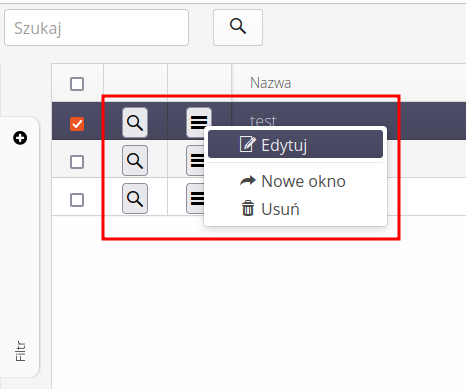
The filter has also been extended with basic filtering capabilities of the dashboard type.
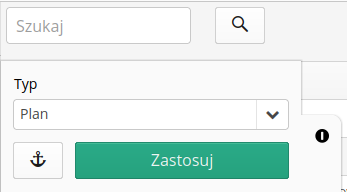
The behavior of the interface in some dialog boxes after pressing the OK button has also been modified (the button is unnecessarily blocked to complete the save operation).
| Availability: Production |
Weekday selectors with default inclusion of all components and description of functions
In editors where we have the ability to specify the days of the week for a given record (inspections, rounds, schedules, calendar), all days of the week are enabled by default. This makes data entry easier for novice users.

| Availability: Production |
Importer - IFC - import of parameters to structures and structure data
The importer of IFC2x3 standard structures has been expanded to import all parameters defined in the model. These data are imported as parameters to Element Types and specified resources. This allows safe handling and synchronization of data in the most complete way.

| Availability: Integrations |
Visualization of IFC files - BimSync - 3D
Added integration with the BIM Sync application[https://bimsync.com] to visualize objects/models using the 3D viewer available there.
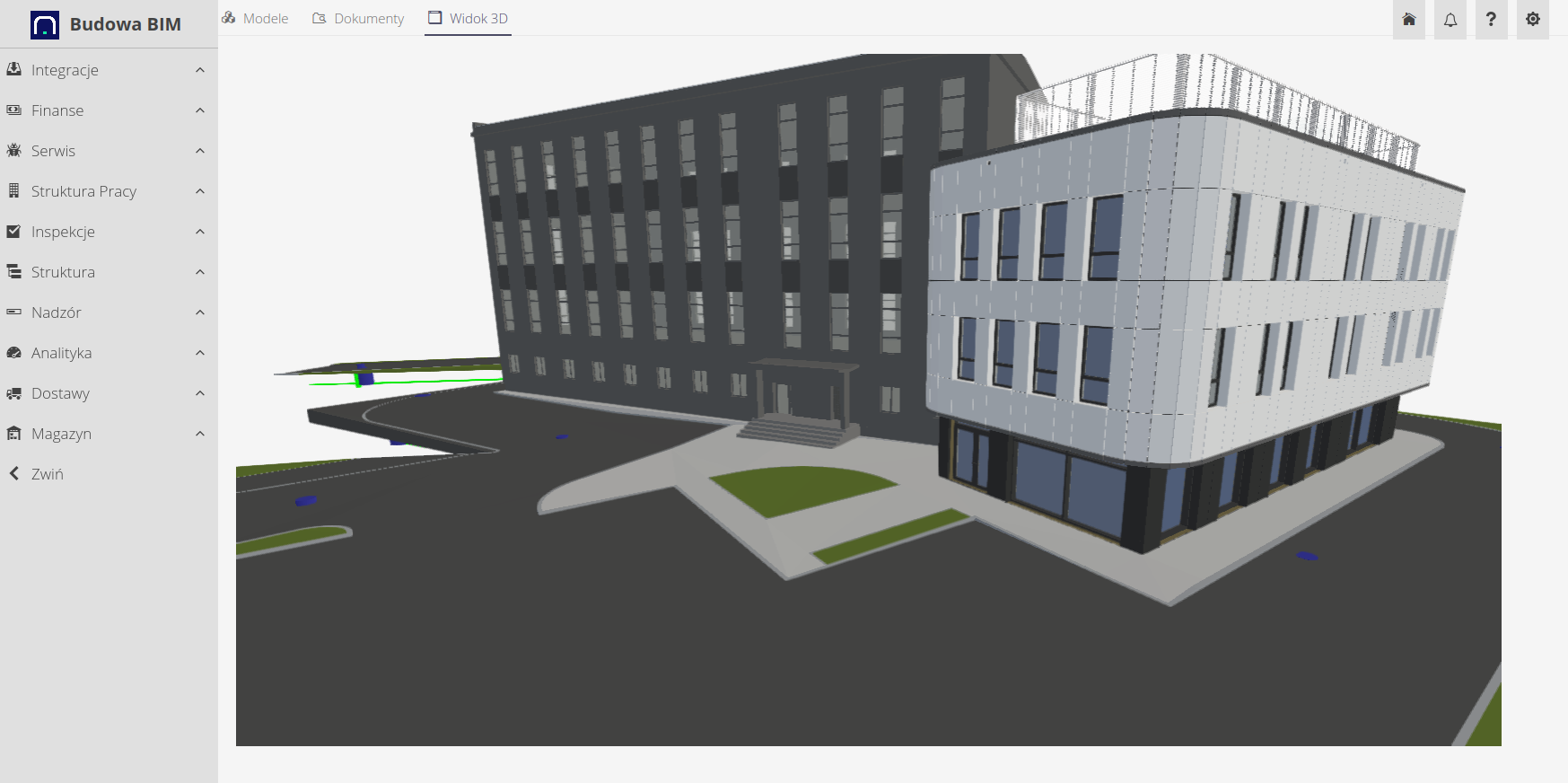
| It is required to have the appropriate license plan in the BIM Sync application and to configure the application/integration from both sides of the projects. More information is described in AMAGE Academy. |
| Availability: Integrations |
Integrations - BIM Sync viewer (documents, models, 3D)
Full integration with the CDE BIM Sync application/environment has been added to transfer/use IFC models and documents contained in the environment. We allow you to browse all documents/libraries available in the CDE environment and use them in the AMAGE application (linking to the resource, imports of the IFC structure)

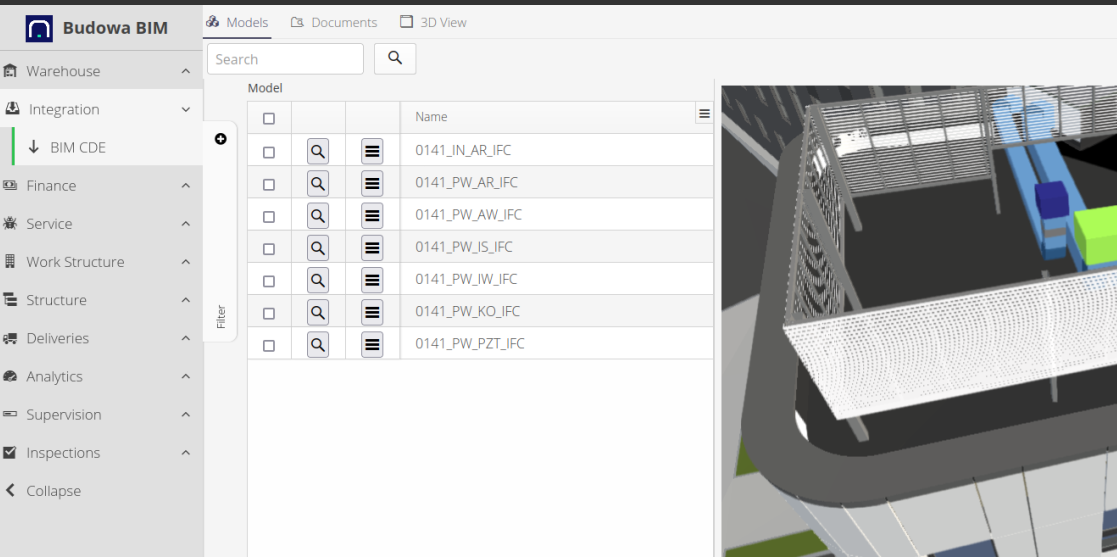
| It is required to have the appropriate license plan in the BIM Sync application and to configure the application/integration from both sides of the projects. More information is described in AMAGE Academy. |
| Availability: Integrations |
Mobile - update last communication date for ApiKey when transmission is active
An update of the last communication date has been added for all mobile devices. This date is visible in the configuration section for each API key separately. This date is automatically updated each time the AMAGE system API is used by any device.
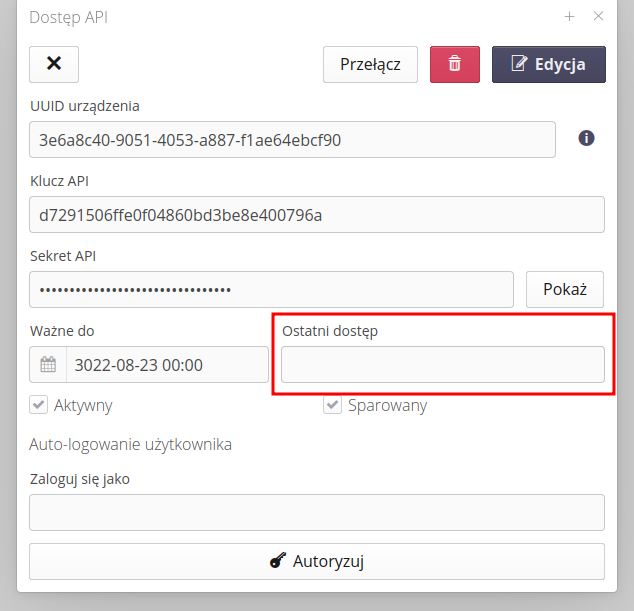
| Availability: Integrations |
Mobile - scheduler notifying when a device is not responding in the aggregator
An automaton has been added that will notify when there is a break in communication with any device supported by the PVD application installed as a remote data aggregator. This allows you to quickly detect a problem with any device and the lack of communication with it, for example, for 3 hours (definable parameter).
| Availability: Integrations |
Scheduler notifying when there is no communication using API keys
An additional automation has been added to generate an alert when there is no communication from external systems using a specific API key. This allows for quick integration diagnostics in detecting problems with the external system.
| Availability: Integrations |
Mobile - scheduler notifying about the lack of response of the aggregator
An additional element has been added to the machines that allows monitoring of communication with the aggregator (edge computing device equipped with the AMAGE PVD application). This allows for quick diagnostics of the available network of remote devices aggregating data from IT devices and systems.
| Availability: Integrations |
Scheduler - preview of scheduler operation
The preview of logs from automated systems has been expanded to include logs from three sources:
-
Automatic Events
-
Automatic data processing machines (Scheduler)
-
Integration endpoints
All data is available in the log viewer in the configuration section.
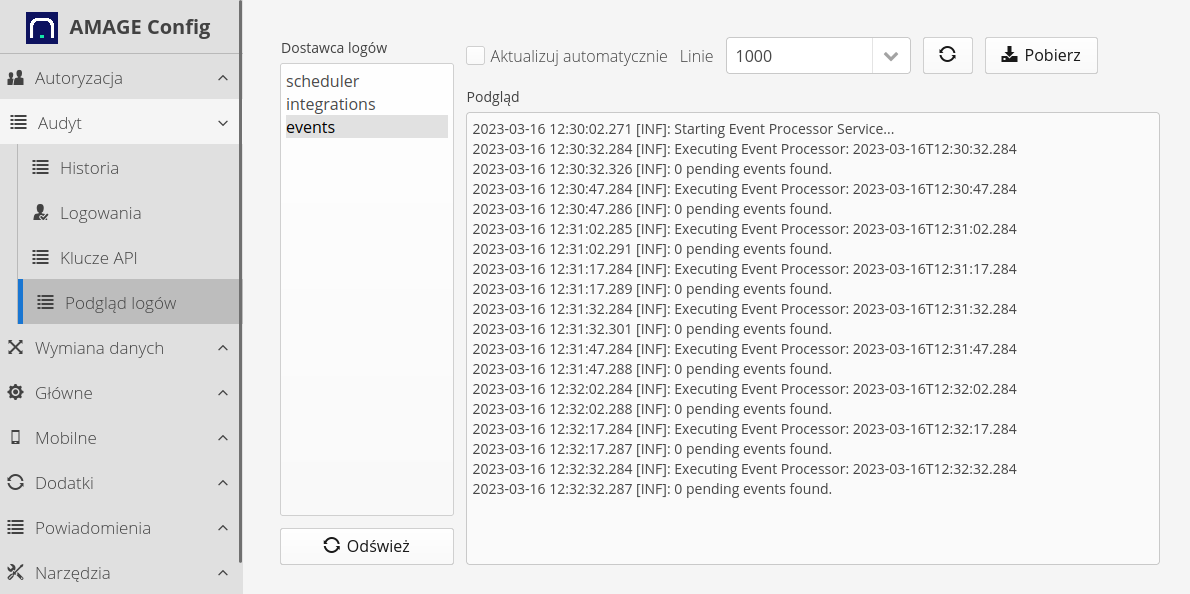
| Availability: Integrations |
Lease importers - make available in the general data import interface
The data import module has been expanded to include a comprehensive data import mechanism for lease systems. Using these importers, we can import data in a combined manner. The possibility has been made available:
-
import of work orders with the creation of a full data structure
-
import of the transport process with creation of order documents, deliveries, delivery checks and corresponding warehouse documents and inventory updates
-
Import assortment with full pricing information and data structure
-
Importing material plans for work orders.

| How to use these importers and their operation for sample data is included in the new tutorials in AMAGE Academy. The importers are only available for systems with lease support enabled. |
| Availability: Integrations |
Instances - system instance viewer for user and management
For users of SaaS systems, a browser of active instances of a given user is available, integrated into the system, with the possibility of creating new instances (versions of the system), e.g. concerning further investments or facilities with maintenance modules. This module also includes the ability to access billing information of SaaS models.
| Availability: Core |
Configuration system menu - changing appearance and functions
The system menu (cog icon) has been redesigned. It is now larger and visually divided into individual functions and access to selected sections of the system.
When the menu is clicked, information about the user in question appears. Buttons allow access to pairing the mobile app, downloading the app for local installation, and viewing the login history of a particular user.
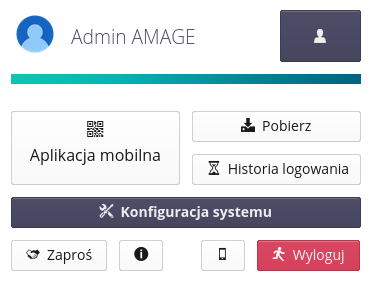
The following functions are available:
-
An icon/username with a button to access basic configurations, i.e., change of email address, definition of photo or electronic signature (for attaching to documents).
-
Mobile app - AMAGE Shell mobile app download/pairing wizard
-
Download - access to download the application installed on computers (Desktop), which facilitates the work with peripherals, such as automatic printing of labels on special printers
-
Login history - access to the user’s login history
-
System configuration - for users with such permissions, access to system configuration (configuration interface)
-
Invite - the ability to invite new users to the system by sending an email with an activation link
-
Information - information about the application (version, license, etc.)
-
Mobile version - switch to mobile view of the system
-
Logout - logout from the application
The login history shows the user’s last logins:

Download desktop applications explains how the application works and provides a download link from our website.
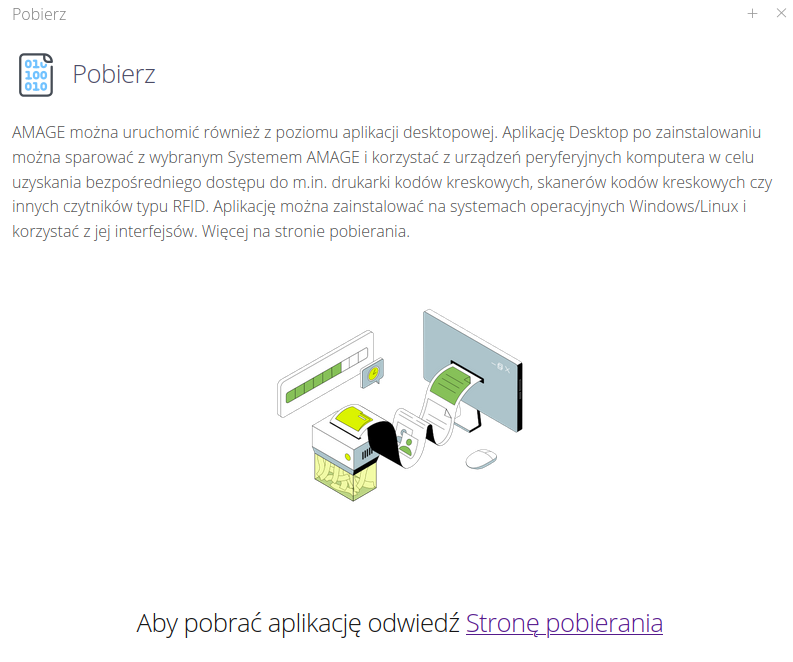
| Availability: Everywhere |
System menu - show mobile pairing
The system menu has been expanded to include the ability to easily install/pair a mobile app.
Select the "Mobile application" action from the system menu.
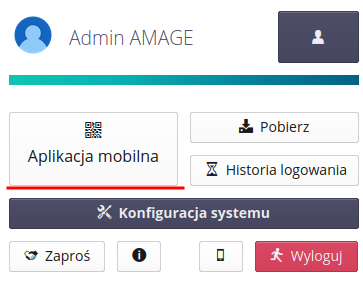
QR codes then appear to download the app to your phone from two online stores allowing installation on most Android devices.
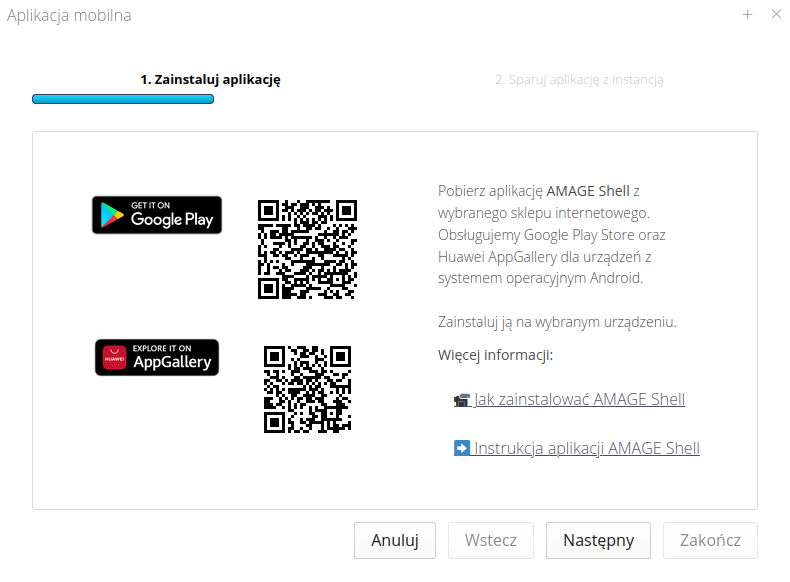
| Unfortunately, for now, the AMAGE Shell app is only available for Android phones. |
The next step displays information about pairing with a particular instance. This code is scanned in the app after it has already been opened on the phone and passed through the initial wizard.
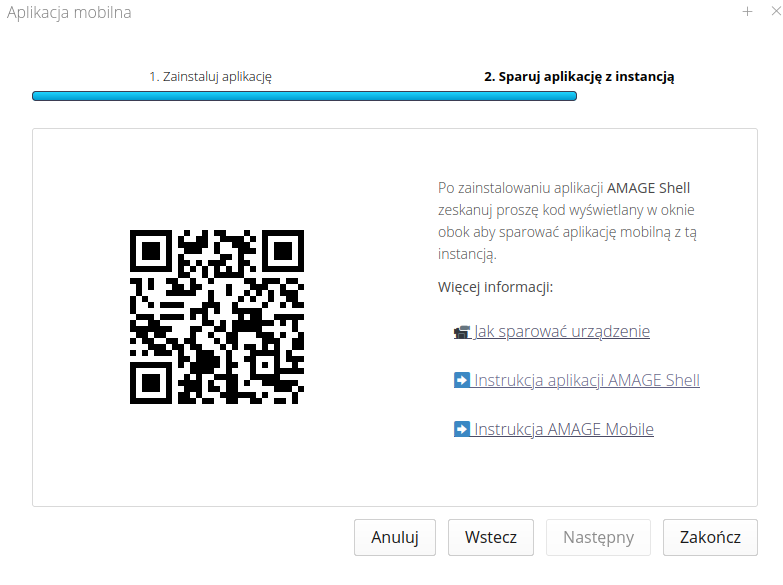
At each step, the system also presents additional materials that allow access to documentation and instructional videos for this process.
| Availability: Everywhere |
User configuration - definition of own photo
In the user configuration, the ability to define a custom photo has been added. This photo will appear in the system menu and can also be used in functional modules, e.g. in modules concerning verification of employee’s authorizations/presence.

| Availability: Everywhere |
Integration - BIM Sync - import/export of IFC models
Integration with the BIM Sync/Catenda Hub system has been extended with direct import of IFC models to the system. Directly from the model browser integrated with Catenda’s CDE system, we can view the model, but also enable the import of the model as resources to a given instance.
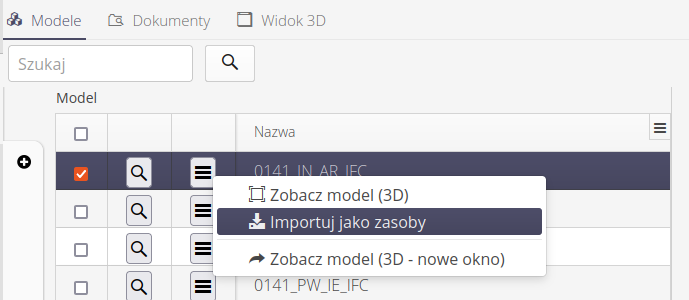
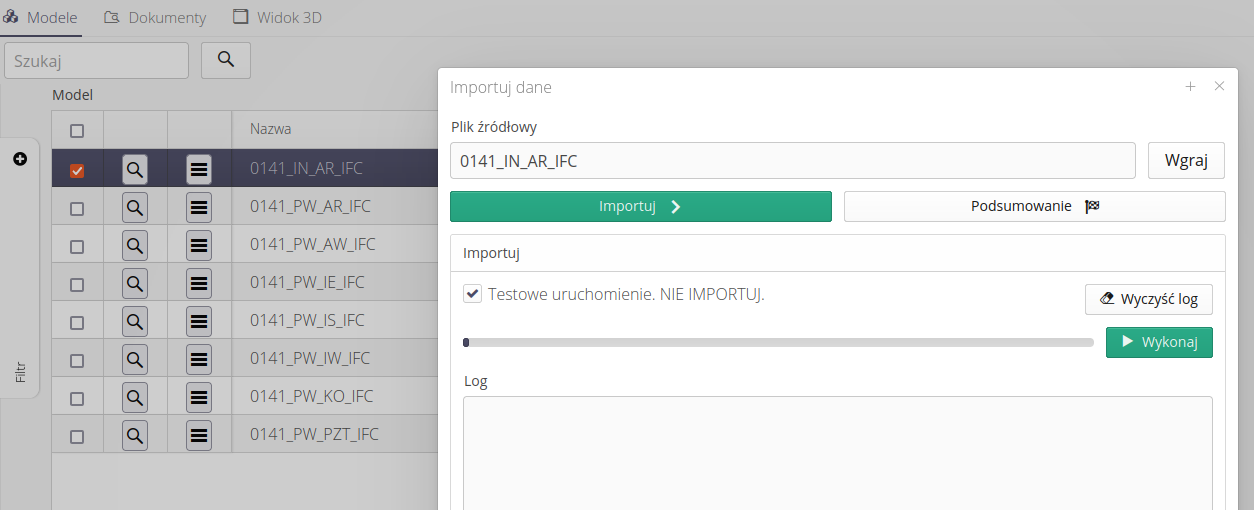
| Availability: Integrations |
Importer - IFC - import of parameters to structures and structure data
IFC model importers have been extended to import all parameters available in the IFC model in accordance with the assigned category and the IfcType description. For each of the resources, data is imported and element types are updated accordingly in terms of parameter definitions and their properties.
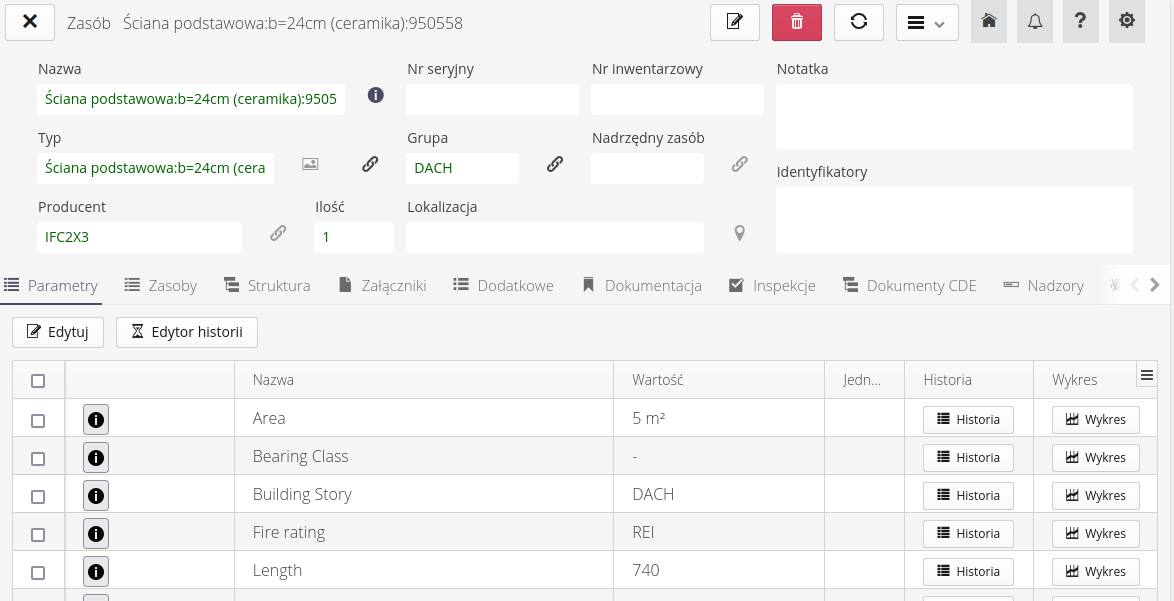
| Availability: Integrations |
BIM Sync - 3D model viewer
The application has been extended with the ability to view the entire project/models generated by the BIM Sync/Catenda Hub environment. We have the ability to display/visualize models and the entire project.
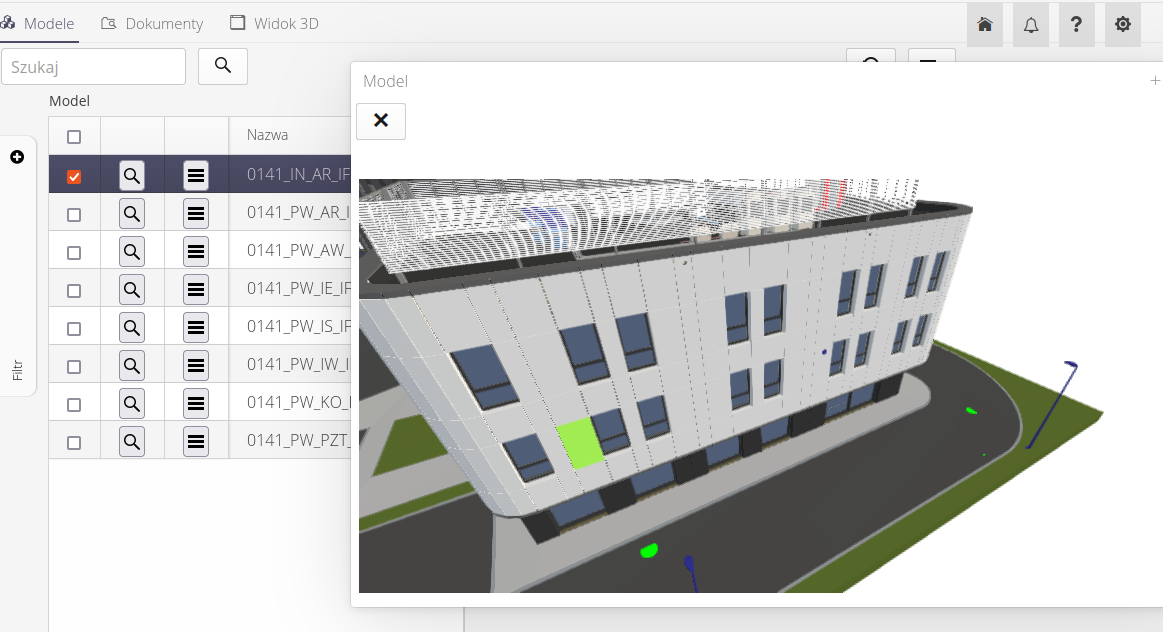
| Availability: Integrations |
Special view - printout of the current view without decorations
The system menu has been extended with an additional button that allows you to display a given system view in a configuration that facilitates printing without additional interface elements (menus, panels, etc.). The function works for all views in the main application of the system.
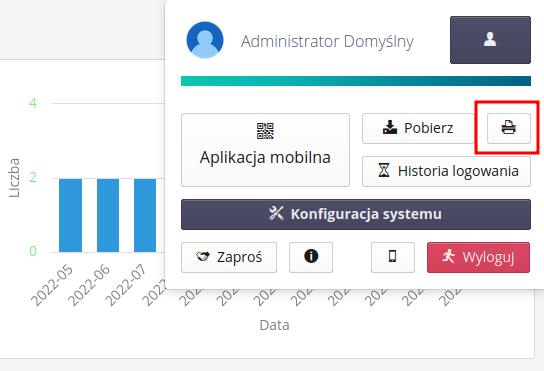
| Availability: Everywhere |
Mobile - start tiles - configurator with a preview of the target appearance
Configuration of the mobile starter allows you to define quick start buttons and access to individual sections of the system in the mobile interface. It often seems useful to be able to display the view of the launchpad view you are just configuring. To do this, a Preview button has been added to the configuration view, which displays the current configuration and view of the launcher panels.
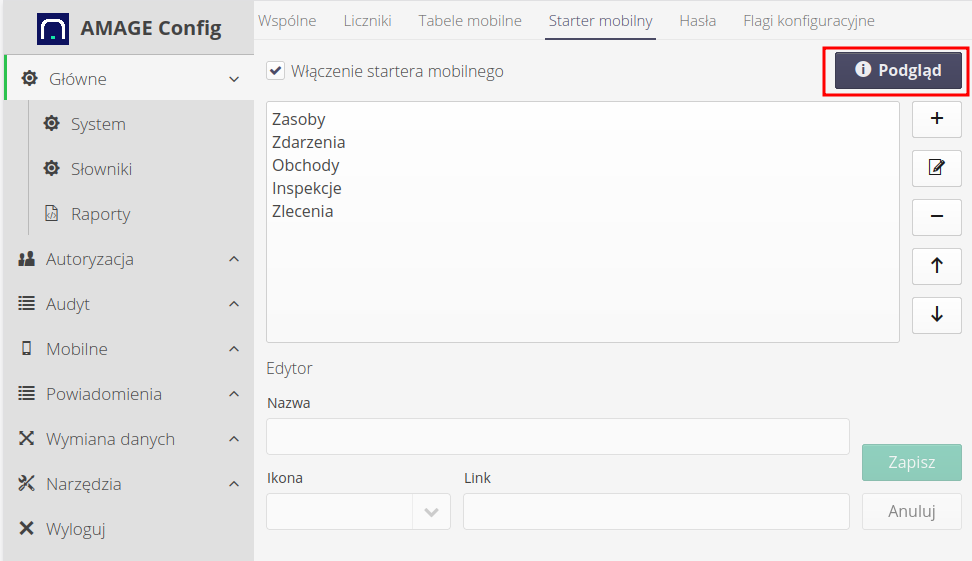
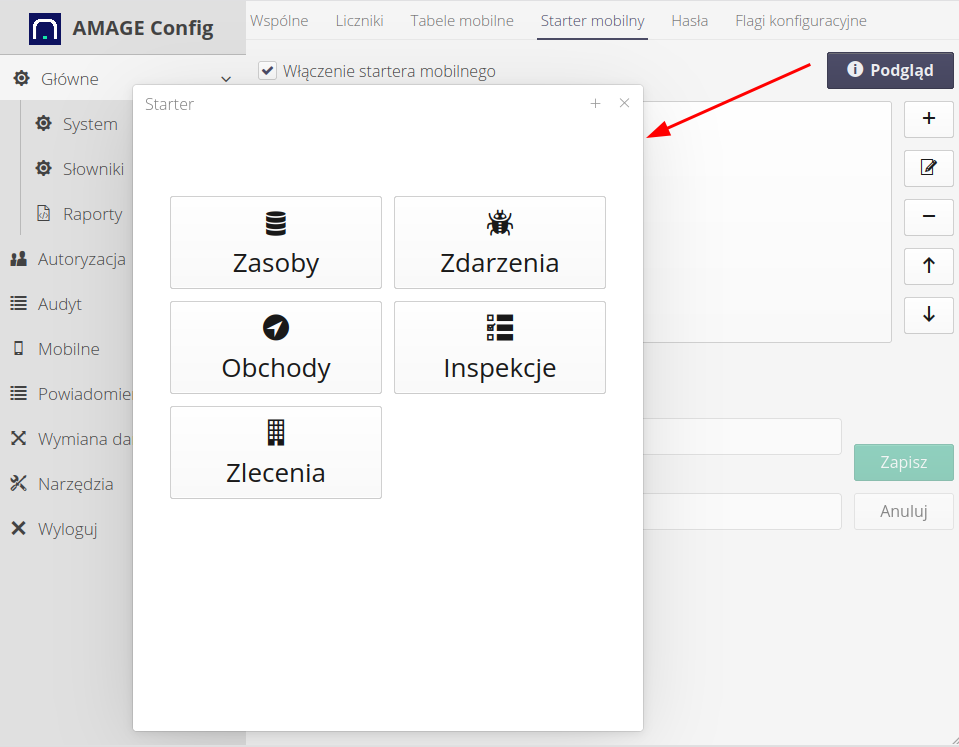
| Availability: Everywhere |
Reports - default Amage Systems logo if no logo is defined in the configuration
If in the application (in the configuration section) the administrator of the instance does not upload his logotypes, the default AMAGE Systems logo will be used during report generation.

| Availability: Everywhere |
Warehouse view - access to warehouse configuration
In the warehouse content view, the option to go directly to the configuration of warehouses/storage locations has been added to the context menu.
This allows quick access to this configuration after system startup.
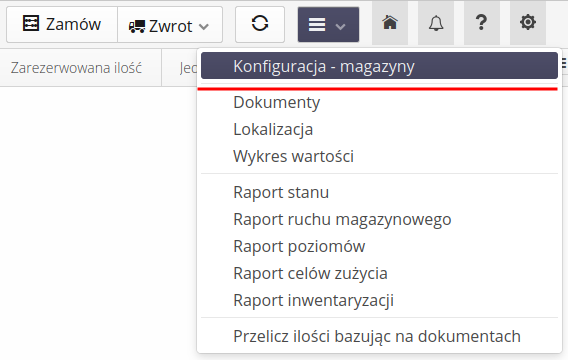
| The configuration of this dictionary data is always in the system configuration view (dictionary data) |
| Availability: Warehouses |
Integrations - SQL - the ability to download data in packages and remember the last processed record
The end of the integration with SQL databases has been extended with the possibility of providing an additional column, the value of which will be remembered between individual queries. This can be used to process records in batches or to process only new records - just remember the key column with this option and then use it in the query.
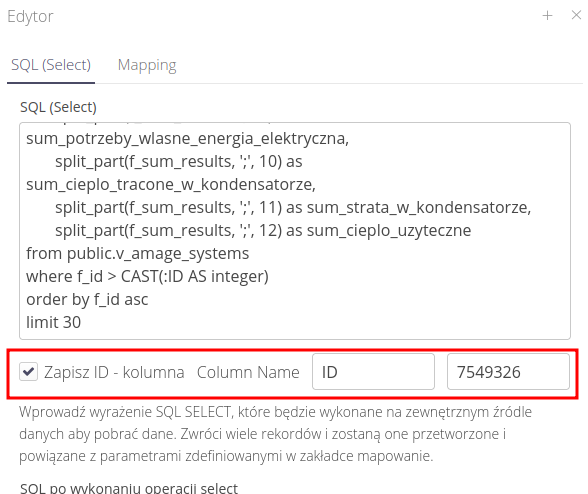
For example. In the query we get the ID column, in the same query we additionally limit the query to 30 records with the where value for the ID field > from the saved :ID parameter. An example record will look like this.
select f_id as ID from public.v_data where f_id > CAST(:ID AS integer) order by f_id asc limit 30
This allows only new records to be fetched and the ID key field to be remembered for the next query.
| Availability: Integrations |
Type parameters - import from excel sheet
When defining an element type, we can define any number of additional parameters for this type. We can do it manually, we can use parameter templates. From now on, you can also import data from an excel sheet directly into a type. This can make it easier to define parameters when we already have them available somewhere.
The import button allows you to load an xlsx file with the structure given in the example:
-
Parameter name
-
Parameter description
-
Unit
-
Category
-
Type (one of STRING, FLOAT, INTEGER, ENUM, DATETIME, DATE, TIME )
-
Default value
-
Regular expression validating the parameter

After selecting the button, we import such a sheet and the appropriate parameters will be created automatically.
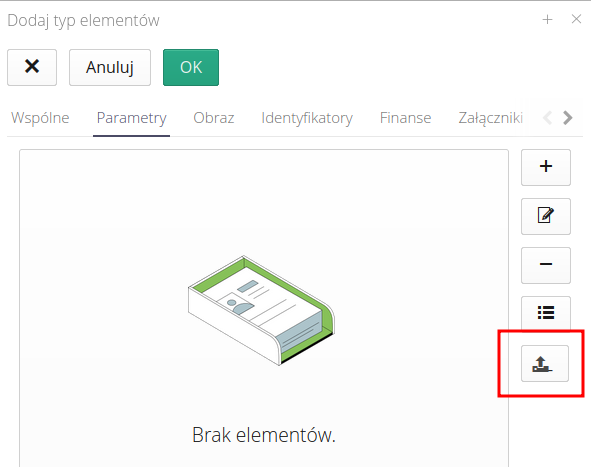
| 1 |
Integrations - SQL - parameters - search by name/description in search of the appropriate record
In mapping integration with external SQL databases, it was possible to download a parameter directly from the source database, e.g. in the exchange table, each record contained the name of the parameter. This allowed to dynamically select parameters from a given resource.
The ability to search the name/description for a found designation in the source database has now been added. This allows, for example, to save the identifier (KKS/TAG) in the description together with other text. The system will find the appropriate parameter anyway.
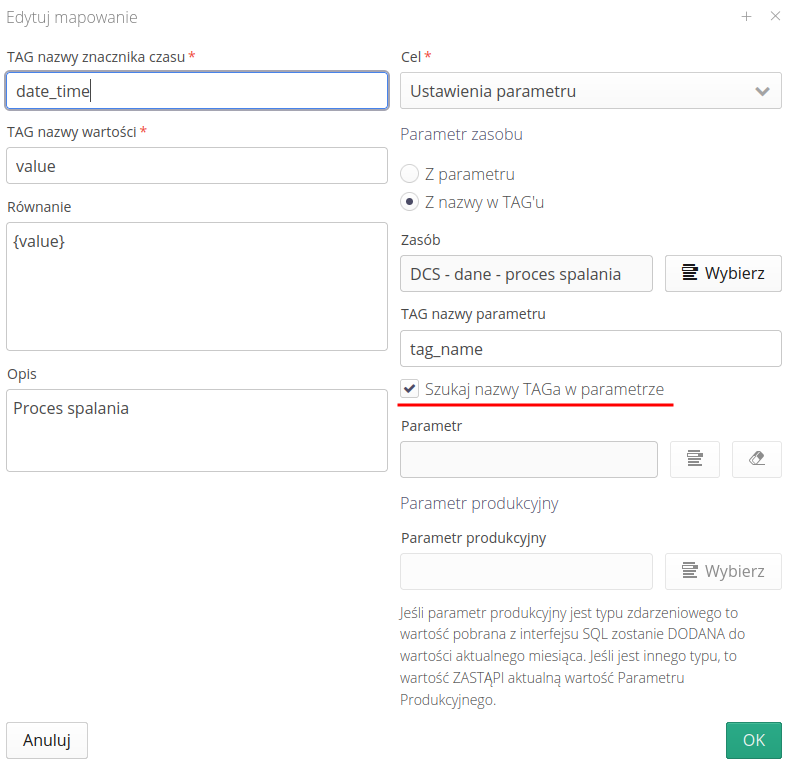
| Availability: Integrations |
Integrations - BimSync - display of the Catenda Hub/BIM Sync view in a separate window
Added the ability to open the CDE Catenda Hub/BIM Sync environment directly from the view in AMAGE. After selecting the appropriate action, the CDE environment opens in a new browser window.
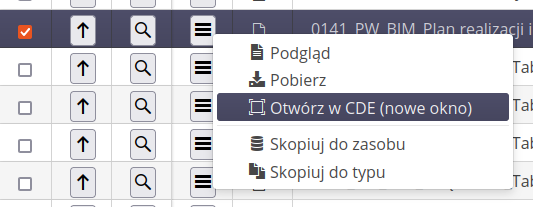
| Availability: Integrations |
Saving the import log for individual importers
All importers save the operation history to the login view. Previously, single object importers did not save this data. From now on, they also save data. We can later view and verify the data.

| Availability: Integrations |
Inspection report - adding information about the resource (S/N, Inventory)
Added display of serial/inventory numbers for a given asset to the standard inspection report.
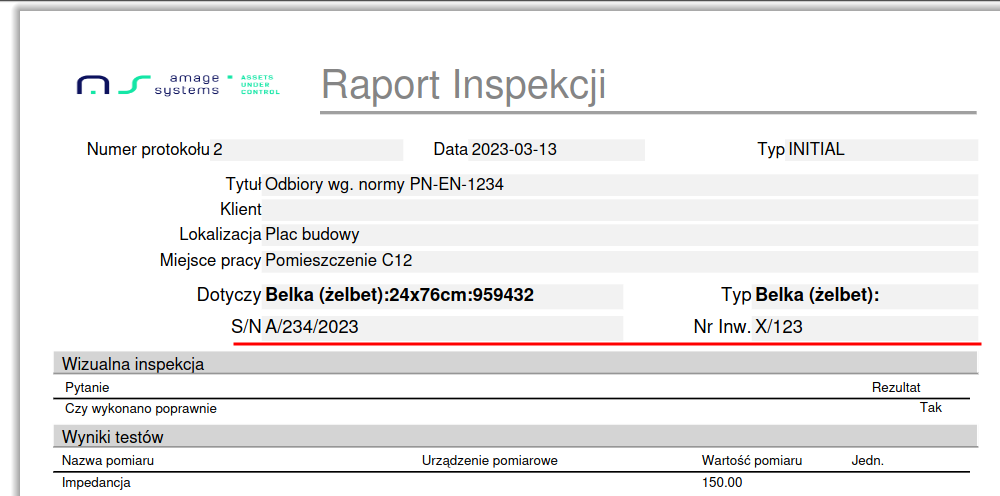
| Availability: Inspections |
Resource parameters - chart, history - default range from the beginning of a given day
In the resource parameters view - history list and chart, the default date range has been changed. From now on, the range of one day is set by default - today from midnight to the current time. This makes it easy to retrieve and display information for large datasets.

| 1 |
Resource parameters - display multiple parameters at once on the chart
Added the ability to simultaneously display multiple parameters of a given resource on one chart. It is enough to select a few parameters and select the 'Graph' option. The data will be displayed in bulk on the timeline.
| All parameters to be displayed must have a numerical type (number) set to enable them to be displayed together on the chart. |
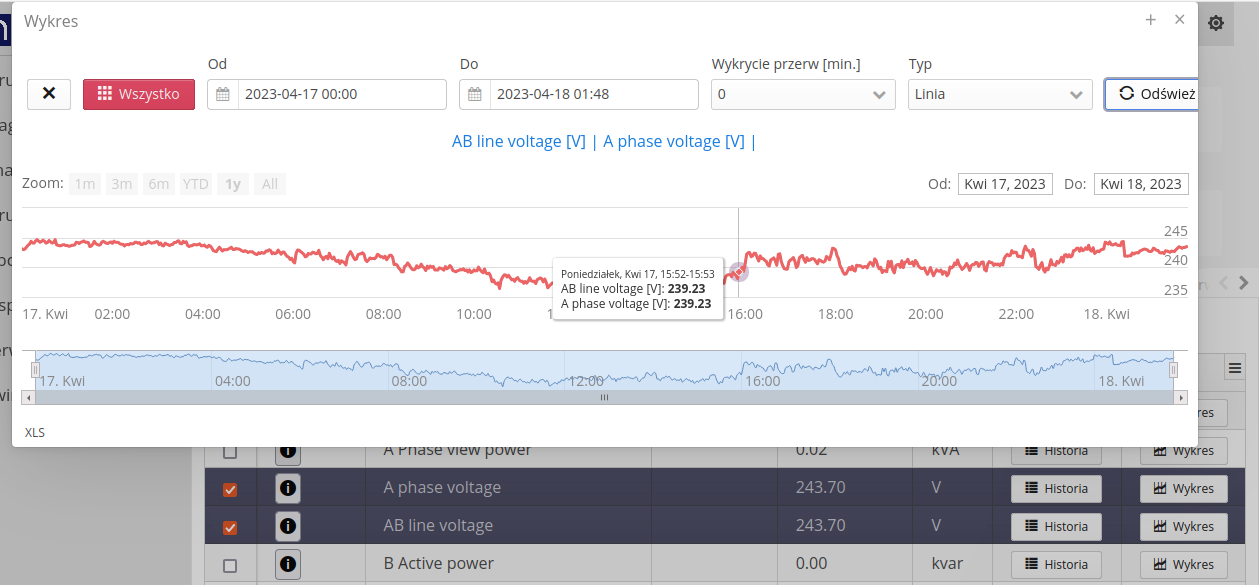
| 1 |
Resource parameters - display multiple parameters at once in the history list
The ability to display multiple parameters in bulk has been added to the parameter history view. This allows you to display data for several resource parameters at the same time according to the set time schedule.

| 1 |
Resource parameters - history - saving data to xls format
In the parameter history view, the ability to export the displayed data to XLS format has been added. Using the button available at the bottom of the screen, we can export the data.

| 1 |
Resource parameters - graph - downloading data with progress
The way of displaying data on the parameter time chart has been modified. From now on, downloading data is performed in the background without stopping the interface. It was especially visible in the case of the time range, which generated thousands of measurements, which could result in the application entering the mode of handling a stopped connection. From now on, after selecting a date range, a dialogue about the progress of downloading data appears.
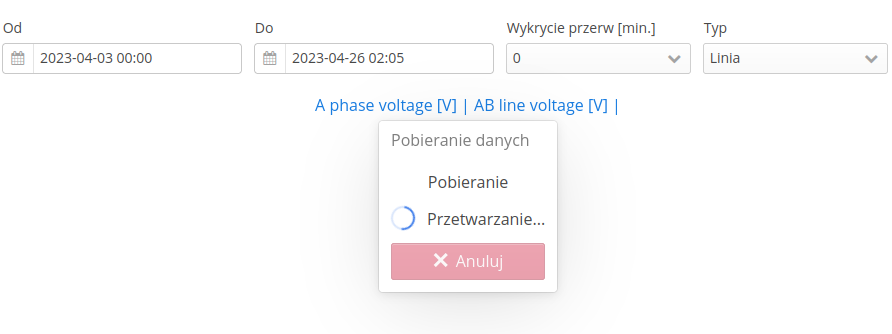
| 1 |
Resource parameters - view displaying data in tabs according to category
The parameter view of individual resources has been modified. After assigning parameters to a specific category, the system groups them and allows you to view parameters according to this grouping.
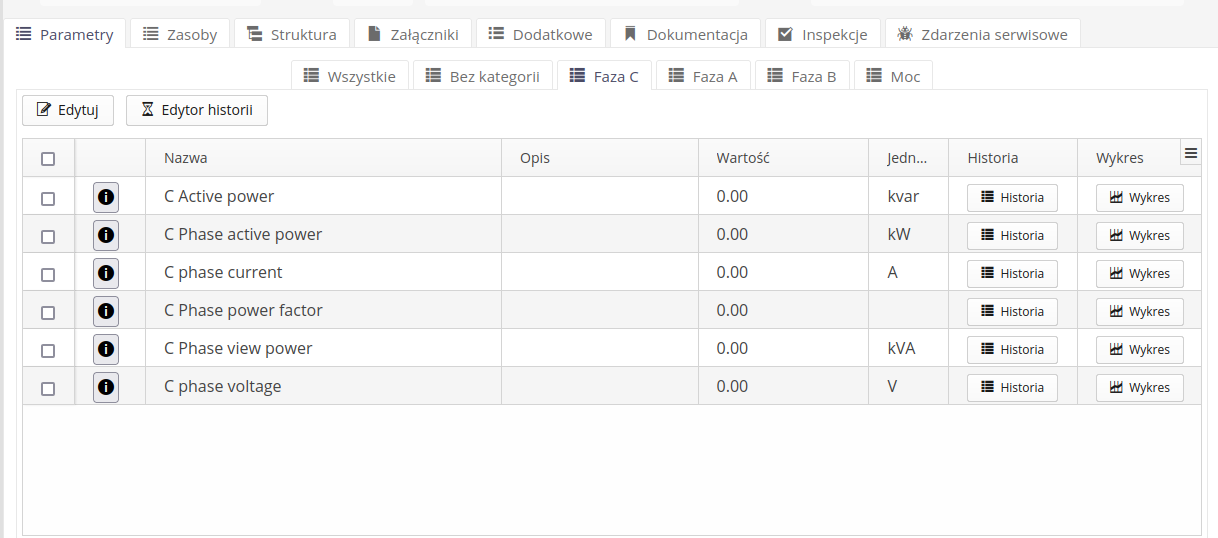
The ability to quickly change categories in the element type view has also been added. Using this action, you can change the category for a set of selected parameters directly from this view.

| 1 |
Mobile - Resource parameters - view displaying parameters grouped by category
The display of parameters has been modified in the resource mobile view. From now on, if the parameters are grouped in categories, the view divides them according to the categories, allowing easier viewing of the data.
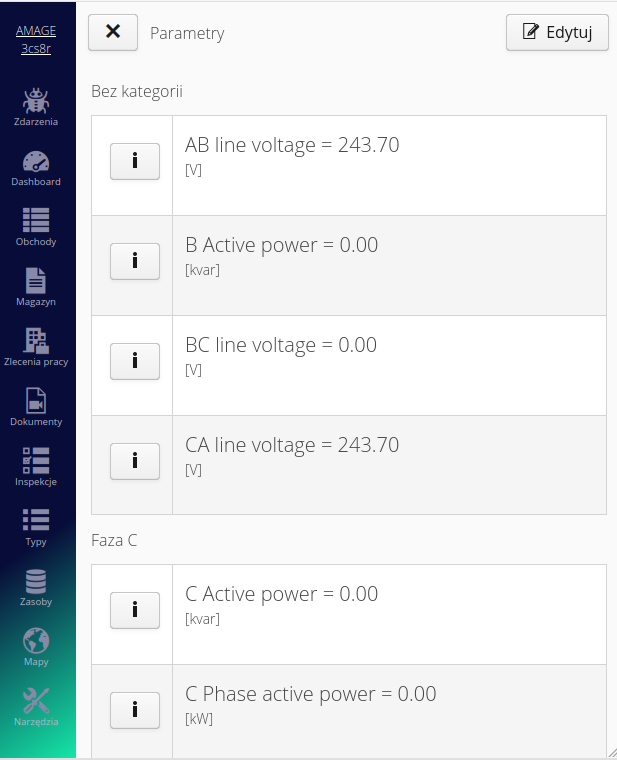
| 1 |
Locations - identifier - add "generate" option
In the location editor, the ability to generate a unique identifier for a given location has been added. Numbering uses internal generators to create a unique identifier in AMAGE systems.

| 1 |
Locations, Product groups, Departments - selector - action of adding a new one with the possibility of indicating a superior element
In the object selectors, which are presented as a tree (location, product group, department), the possibility of creating new elements, taking into account their placement in the tree structure, has been added. To add a new object in a given place in the tree, just select the parent element before invoking the add action.
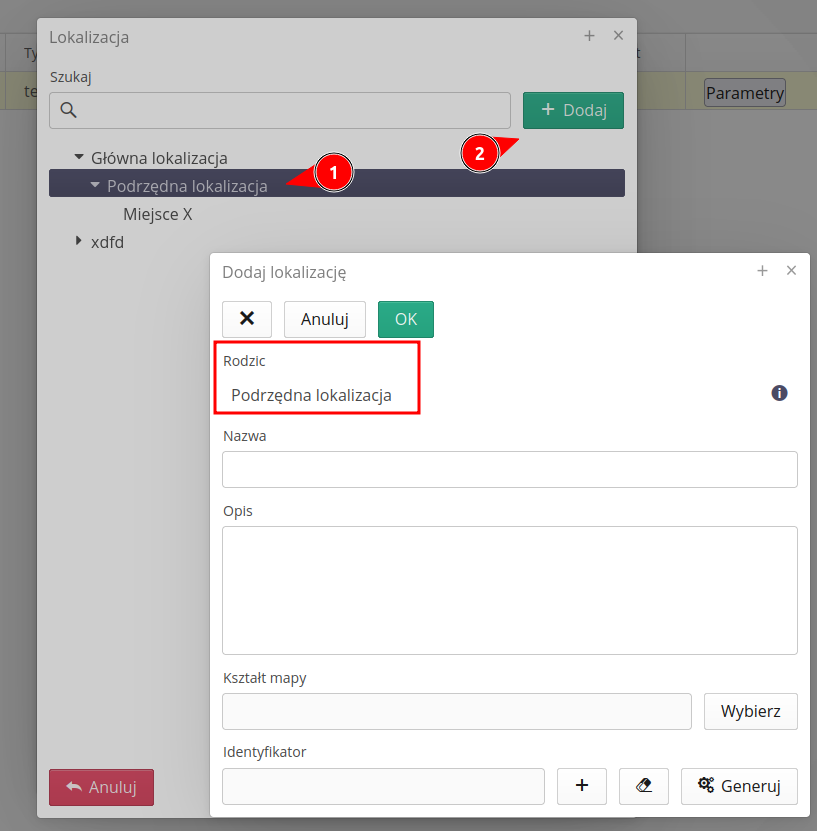
| 1 |
Maps - map selector with a button to indicate the current location
In the map selector, a button has been added that allows you to go to the current geographic location provided by the browser/system on which the application is running.
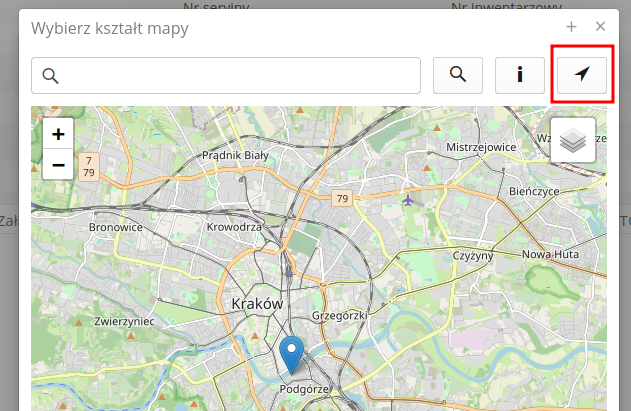
| 1 |
Supervision - supervision template - prompt last entered value
The ability to specify whether to provide the last entered value to the user when entering supervised parameters has been added to supervision. This makes it easier to report data and avoid potential errors. This option is enabled for each monitored parameter separately.

| Availability: Supervision |